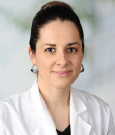The incidence of melanoma among children, adolescents, and young adults has reached epidemic proportions, increasing more than 250% over the past 4 decades, with young females at highest risk for the deadly cancer, according to a study1 by researchers at Roswell Park Cancer Institute in Buffalo, New York. According to the Skin Cancer Foundation, melanoma is the most common cancer for young adults aged 25 to 29 and the second most common form of cancer for people aged 15 to 29.2
While excessive unprotected sun exposure and the use of commercial tanning beds are two of the major culprits in the increasing rates of melanoma in this age group, other factors may be at play, including genetics, according to two of the study’s authors, Demytra Mitsis, MD, Fellow in the Department of Medical Oncology at Roswell Park Cancer Institute, and Nikhil I. Khushalani, MD, Associate Member of the Cutaneous Oncology Program at Moffitt Cancer Center in Tampa, Florida.
The ASCO Post talked with Drs. Mitsis and Khushalani about the results of this important study, which was recognized with an ASCO Merit Award during the 2015 ASCO Annual Meeting. The authors also discussed the need for better prevention and screening strategies for melanoma in the adolescent and young adult population as well as for more research in the biology of melanoma in this age group.
Tanning Bed Connection?
Your study found that a disproportionate number—over 60%—of adolescents and young adults diagnosed with melanoma are female. Do you know why young women are at greater risk for developing the cancer?
Dr. Mitsis: We initially did the study because we had noticed an increasing proportion of young patients in their 20s and 30s diagnosed with melanoma establishing care in our clinic at Roswell Park Cancer Institute. We wanted to investigate the incidence and survival trends in this age group over the past few decades. Our results were staggering, not just in the increasing number of cases of melanoma during this time frame, but in the rapid rise specifically in young females.
We know that the use of commercial tanning beds has become popular over the past few decades, and this is likely a contributing factor to the increase in melanoma incidence that we saw. Over 70% of tanning salon patrons in 2013 were Caucasian girls and women primarily aged 15 to 29.3 Looking at our data, the median age range in our female adolescent/young adult group diagnosed with melanoma was 32, so it is definitely a concerning finding.
Recently, a number of states, including California, Delaware, District of Columbia, Illinois, Louisiana, Minnesota, Nevada, New Hampshire, North Carolina, Oregon, Texas, and Vermont have banned the use of tanning beds for minors under age 18, and it will be interesting to see if the incidence of melanoma in this age group changes over the next decades.
Other Factors
Is ultraviolet (UV) radiation from excessive sun exposure and tanning bed use, while not taking enough sun protection measures, the main reason for the high incidence of melanoma in this population?
Dr. Mitsis: It is, but other factors may also be at play. Large studies have been done in Australia, which has one of the highest rates of melanoma in young people, and they found that nevi, facial freckling, family history, and eye color were also associated with an increased risk of developing melanoma. So, genetic predisposition may also be a primary determinant.
It is important to reinforce that the risk of developing melanoma in younger patients is likely the result of an interaction between genetic and environmental factors. Our study was not a case-control analysis, but there are definitely data showing that in the adolescent and young adult group, an individual with a susceptible pigmentary trait or a family history of melanoma may be more susceptible to developing melanoma.
Biologic Differences
Are melanomas in adolescents and young adults biologically different from these tumors in older adults?
Dr. Khushalani: The question really is: Is there an inherent difference in the biology among children, young adults, and older adults? And the simple answer is we do not know yet. Part of the reason for that lack of knowledge is because we don’t traditionally consider melanoma to be a common disease in young children or young adults.
A study4 by researchers at Moffitt Cancer Center, which looked at data on about 120 patients aged 29 and younger, found that melanomas in children are deeper and thicker and are associated with a higher incidence of lymph node metastases—almost double the rate you would see in adults. In adults, the incidence of lymph node metastases is roughly between 12% and 15%, whereas in children, it was about 30%, which biologically makes sense because deeper melanomas do have a higher preponderance of spreading to lymph nodes.
What I infer from that study is that we are not diagnosing these patients at an early enough stage, so we need better screening and prevention strategies in this age group. That will take more public education about the risk of skin cancer in young people.
The good news is that despite the study results showing a higher incidence of lymph node metastases in those children, their survivorship rate was actually very good, even better than for adults. So the researchers’ conclusions were that you should treat adolescents and young adults with melanoma as you would an adult, and you should treat the cancer aggressively.
What we are learning about melanoma in this population is that the incidence is definitely increasing, and you have to ask why. Is it that more children and young adults are getting melanoma, or is it that we are getting better at diagnosing this cancer and picking it up earlier? This is clearly an area that has to be explored.
Research and Treatment
Please talk about the need for more research in this age group and for better skin cancer prevention and treatment strategies.
Dr. Mitsis: Looking at the design of future studies, we definitely need continued translational and molecular research to investigate the specific differences in melanoma in young and older adults. Some very preliminary microRNA profiling data have been used in attempts to answer this very question, with the ultimate goal of finding useful biomarkers that predict outcome in the adolescent and young adult age group. We are not quite there yet, but this is an exciting time for melanoma research in this population.
Dr. Khushalani: There is no question that this is a public health problem that needs to be tackled. At least in a good majority of patients, this is such a preventable disease. We all like to be out in the sun, but we need to protect ourselves and our children from the sun’s UV rays and to know the signs of a mole or skin lesion changing to melanoma, because this is a disease where an increase in depth of even just 1 mm can be a matter of life and death. People always wonder how a mole that is only 2 or 3 mm deep can cause so much havoc. But that is the unfortunate truth about the biology of melanoma.
Screening Guidelines
Are there screening guidelines for melanoma and other skin cancers?
Dr. Mitsis: Currently, the U.S. Preventive Services Task Force has no official screening guidelines for skin cancer in adolescents and young adults. People should be aware of skin changes. Examining skin regularly and seeking medical attention with evidence of changing moles or new moles with abnormal features are important.
Preventing these cancers from occurring in the first place is the goal. Teaching sun safety education to children and adolescents so they develop effective prevention strategies is key. Avoiding commercial tanning beds as described earlier is also a message we need to send to young people.
Closing Thoughts
Is there anything else you would like oncologists to know about the prevalence of melanoma in the adolescent and young adult population?
Dr. Mitsis: Most importantly, we want to raise awareness among oncology practitioners and the general public that there has been a rapid rise in the incidence of melanoma in this age group and that the ratio of incidence in females to males is increasing, so young Caucasian females especially need to do whatever they can to reduce their risk factors for this cancer. It is wonderful that survival rates in adolescents and young adults have improved, but we would really like to see fewer cases of this cancer.
There is a need for more research investigating the specific biologic differences in melanoma between this age group and adults, because the treatment regimens and guidelines we are using were developed based on data from older adults. We want to increase adolescent and young adult participation rates in clinical trials so we have data specifically for this age group in terms of tumor characteristics, biology, and treatment response rates.
Dr. Khushalani: Unfortunately, cancer is a disease that affects individuals spanning from the youngest to the oldest, but, encouragingly, we have the ability to potentially prevent melanoma. We also have the potential to treat these patients very aggressively with very good outcomes. So all is not bad here. The key really is in raising awareness. ■
Disclosure: Drs. Khushalani and Mitsis reported no potential conflicts of interest.
References
1. Mitsis DKL, Groman A, Beaupin LM, et al: Trends in demographics, incidence, and survival in children, adolescents, and young adults (AYA) with melanoma: A Surveillance, Epidemiology, and End Results (SEER) population-based analysis. 2015 ASCO Annual Meeting. Abstract 9058. Presented June 1, 2015.
2. Skin Cancer Foundation: Skin cancer facts: Melanoma. Available at skincancer.org/skin-cancer-information/skin-cancer-facts#melanoma. Accessed October 19, 2015.
3. American Academy of Dermatology: Dangers of indoor tanning. Available at aad.org/media-resources/stats-and-facts/prevention-and-care/indoor-tanning#.uyxakrvvhqm. Accessed October 19, 2015.
4. Han D, Zager JS, Han G, et al: The unique clinical characteristics of melanoma diagnosed in children. Ann Surg Oncol 19:3888-3895, 2012.
GUEST EDITOR
Adolescent and Young Adult Oncology explores the unique physical, psychosocial, social, emotional, sexual, and financial challenges adolescents and young adults with cancer face. The column is guest edited by Brandon Hayes-Lattin, MD, FACP, Associate Professor of Medicine and Medical Director of the Adolescent and Young Adult Oncology Program at the Knight Cancer Institute at Oregon Health and Science University in Portland; Senior Medical Advisor to the LIVESTRONG Foundation; and Chief Medical Officer of Critical Mass: The Young Cancer Alliance.




